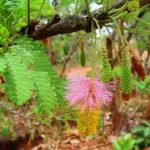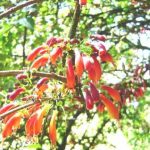TREE LIFE
May 1993
NOTICE OF THE ANNUAL GENERAL MEETING
Notice is hereby given that the 43rd Annual General Meeting of the Tree Society of Zimbabwe will be held on Sunday 16th May 1993 at Strathmore Farm, Gommonzi at 10.30 hours.
AGENDA
- Notice convening the meeting
- Apologies
- Minutes of the 42nd A.G.M.
- Matters arising
- Chairman’s Report
- Treasurer’s Report
- Election of – Committee Members
- Any other business
Any proposals/resolutions and nominations for office bearers should be forwarded to P 0 Box 2128 Harare by Monday 10 May 1993 if possible, although Proposals and nominations will be accepted from the floor.
MASHONALAND CALENDAR
Tuesday 4th May: Botanic Garden Walk at 1645 hours for 1700 hours. Park at the Herbarium where we will meet Tom Muller
Sunday 16th May : A.G.M. at Strathmore Farm Goromonzi, where once again John and Jill Marr-Levin are so willingly providing the venue. The farm overlooks the Nora Valley. Refreshments will be served at 10 am for which contributions of cakes or sandwiches will be most welcome. .
Saturday 29th May: Marks Botanical Interest walk will take place on the 5th Saturday because a. pufiiic holiday falls on its usual slot. We’ll meet at 3 pm at the corner of Harare Drive and Leamington Road, Borrowdale.
Saturday 5th June: winter season again (groan). Botanic Garden walk on Saturday morning.
MATABELELAND CALENDAR
Sunday 2nd May: A morning visit to Leopard Rock Kopje on the Khami Waterworks Road. Rendezvous at Girls‘ College car park off Pauling Road for an 0830 hours departure.
Monday 10th May: Urban Trails Hillside Dams at 1645 for1700 hours
Sunday 14th June : Beaconsfield Farm
Monday 7th June : Urban Trails
CHAIRMAN’S REPORT
It gives me great pleasure to submit this report for the year 1992-1993 at a time when our society is well into the fifth decade of its existence.
It has become customary here to summarize the main activities of the year, and in particular our eleven “third Sunday” events.
The A.G.M. in April saw us at Serui Source Farm, where we had been before. I stress this, because it is always good to know that our gracious hosts are prepared to have us back again after the first time. This meeting carried with it a sad tone because we had to accept the departure of Kim and his family from Zimbabwe.
In May we ventured into the Msonedi district. At Vuruneme Fam, dam side between granite hills, we were forced to acknowledge the worst drought in the short history of records in Zimbabwe.
June saw us again on familiar ground at Chedgelow Farm on the lower Ruwa, and here we moved in a veritab1e riot of aloe blossoms.
In July we made a. return trip to Golden Star Farm, Shamva District, where in addition to a wealth of learning about trees, we saw something of gold mining and the problems of illegal panning along the Mazowe.
August found us at Pax Park, the Girl Guides site on the south side of the Lake. Drought now with a. real grip on the land, we faced the tree outing organizers night- mare. Near complete leaflessness, but in this familiar environment we found we could identify nearly every tree without any leaves.
In September we re-visited Eyres Pass through the Dyke, always an exciting venue.
Hot October, with meagre cloud build up found us on a repeat visit to Gosho Park, a first time there for myself and I found it fascinating.
November took us again to the Mazowe Valley to Rob Pare’s butterflies, and we were enchanted both by the insects themselves and the little plantation created for them. We lunched on the banks of the Mazowe river hiking through another game enclosure through bush as leafless and arid as we would never have believed possible in Mashonaland. This day, however, for the first time we saw really impressive cloud build up, but still no rain.
January with drought barely broken we moved marginally outside the city boundary to Ventersberg Farm where it was a pleasure to see one of the sources of the Ruwa flowing well and as a sign that the drought is in fact still with us, at the time of writing none of that water we saw flowing so happily then, ha yet reached even the upper of the city’s storage dams.
February saw us breaking into new territory, Musa Farm on a headwater stream of the Mkwodzi, and to celebrate a rainy season, in a semblance of primitive rites of rain dancing, we all got soaking wet.
We wound up the administrative year downstream at the new Lake – Mazvikadei – an interesting trip to end the year.
Our gratitude to our hosts, and the organisers for a full year of great interest. The year also saw a full programme of Botanic Garden walks, as popular as ever, as they have been for the last twenty years so once more we express our gratitude to Tom Muller for being so generous with his time, his science and his humour.
The other regular item on our calendar, Mark Hyde’s Saturday afternoon walk in a place of interest within the city, has proved very popular. Thank you Mark.
Up to here I have been reporting to you as leader of Mashonaland Branch and chalking up the years highlights for that section. I must now put on that other hat, the one which makes the Harare Chairman ( in terms of our Constitution) also Chairman of our National organisation.
The other two branches continue to prosper in their chosen fashion.
The Ayrshire people we meet frequently, they are also Mashona. Matabeleland members we meet less often, but here, through the medium of our modest publication Tree Life, we keep in touch and Harare people are able to admire the vitality and variability of the Matabeleland calendar.
Having touched briefly on what we have been doing during the year, it remains for me to comment on what we have achieved as a conservation body. Our psychological balance sheet so to speak.
To pursue the simile, I must examine the matter of supp1y and demand. What do you our members demand from us, the management committee and do we supply sufficient to satisfy these needs.
As in any enterprise, consumption of our product is the key. We produce this programme of events, and you the members turn up in substantial numbers. We produce our modest monthly publication and you the readers provide us with feed back that each issue is well received.
To further monitor our business, you the members promptly renew your annual subscription, providing the finance to fuel our activities.
So the psychological charts recording our activities show successful operations. Or do they? Is there not a danger that this routine success is creating a kind of complacency. To switch my figure of speech away from business activity, and to the tree life which we study, is there not a danger that in this fifth decade of our existence we are now coming to resemble PARINARI, and have settled into a routine, dooming the organism to slow decay at some time in the future, or do we still seem like genus BRACHYSTEGIA, dynamic and evolving before our very eyes.
We are a conservation body, in a small way we have a good name as such, but perhaps we are too isolated and secure within the cosy cocoon of our programme of activities. After all, out there is environmental hazard, a planet in peril. So should we be doing more than merely meeting monthly to admire the flora. As a society we have worked hard in the past on conservation projects and in terms of clause 2(a) of our constitutions, to create awareness amongst the public. If we are to continue to exist into the twenty first century, should we not be doing more real conservation work now? well, if so, we are a. democratic body, we will require you the members to give us your instructions .
A word about our membership. Habitually I, do not hesitate to refer to our society in a diminutive sense. I term us as a small society. Above I refer to Tree Life as a “modest” publication. We have 263 members, 242 ordinary, 8 honorory and 13 associates. ‘ Ten of this total are outside Zimbabwe. So, we are small but this should cause us no concern, it is the quality that counts.
So, following this train of thought, to close this report, I wish to express my thanks to this small, but individualistic membership for their support during the year under review. It is always good to hear from the outlying members if I may coin a phrase, and I would like these members when we meet in person rarely, to know, that we acknowledge you are as important to the Society as those we meet every month.
HIGHBURY ESTATES – MHANGURA
A cool highveld morning turned out to be a fantastic sunny day once we reached Highbury estates. With the recent rains the “drying out” of the bush had been staved, promising an interesting time.
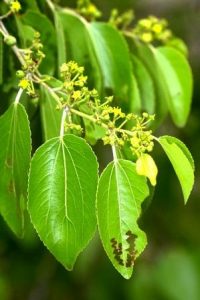
Zizyphus mucronata. Photo: Bart Wursten. Source: Flora of Zimbabwe
Some disastrous navigation, resulting; in three wrong turns, eventually brought the group to the “sterculia.” kopje near the original Highhuy homestead. Following the track along the base of the kopje, thickets containing many Zizyphus mucronata laden with fruit were noted as well as several large Acacia nilotica close by. The mature grass and weed seeds caused much annoyance with various members sitting down the path and attempting to eject the irritants from their shoes and socks.
With only a hundred or so metres to go through the weeds a thicket on a temite mound produced several species growing in close proximity including Diospyros kirkii, a heavily predated Maytenus heterophylla and a number of Commiphora mossambicensis.
A number of Azanza garkeana along the path indicated its direction – perhaps the rain makers indulged in some sustenance before performing their ceremonies on the hilltop. Finger like bunches of bright red Friesodielsia obovata fruit caught our eye whilst clambering through a particularly rocky spot. Just above in a rocky ledge lurked a small Combretum pyracanthoides (our 5th Combretum species today) its extremely spinescent branchlets caused anguish to exploring fingers.
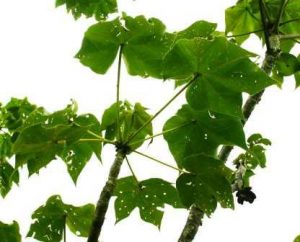
Stercullia quingueloba. Photo: Bart Wursten. Source: Flora of Zimbabwe
A strong vanilla-like scent floated past on a breeze and was traced to a group of flowering Stercullia quingueloba – a most unusual sight. Near a Pterocarpus angolensis with an almost geometric pattern on the bark, Dave noticed a pink jacaranda – Stereospermum kunthianm in a rock crevice, its grey bark had peeled to show an unusual cream coloured under bark. Close to the summit surrounded by the remains of some ancient walling, Rob Barrett explained what he thought the scene would have been some 300 years ago.
The semi-circular wall was probably part of a defensive structure (useful if one incurred the displeasure of a brother-in-lawl), the livestock being kept in the lower part of the enclosure with the huts some twenty metres away on higher ground. Not much evidence of broken pottery etc. from that period was noticed but many bits of broken pottery were noticed presumably the result of more recent rain making ceremonies. Rob suggested that the area was probably occupies by the Tonga and Lola tribes, who were copper workers as evidenced by save-ml ancient copper claims in the area, until they were displaced by tribes moving north-wards from the Masvingo area.
A bushbuck doe rushing past the group ended the historical discussion and we proceeded to the summit, passing a huge Albizia amara on the fringe of the walling. A spray of pink to mauve flowers on an Ormocarpum kirkii and a Balanities aegyptica added variety to the Brachystegia woodland.
Following the fence line down the hill several of the Ficus species were seen, including F.sycamorus and F. sur. At the base of the kopjie an enormous Kigelia africana groaning under its load of sausage like fruit. What a sight! Within a few minutes a clump of Grewia monticolar and Rhus longipes on a termite mound next to the car park signalled the end of the morning’s ramble.
Mike had very kindly cut a path through the grass for us to park our vehicles at the lunch spot. Lunch was eaten in the shade along the Munwa river. Not much “Treeing” took place after lunch but a short walk produced several large Acacia polyacantha, lots of Carissa edulis (with some in fruit). Cassine aethopica and Combretum erythrophyllum with a few Phoenix reclinata (date palm) completing the picture.
When we returned to the farm, several members bought candelabra type candle sticks from Jenny, an elegant insurance against future acts by Zesa.
Our most grateful thanks to Mike, Jenny and Grace for all the effort they put into making the outing so enjoyable and to Rob Burrett for his most interesting impromptu archeological talk.
-Hansel
NYARUPINDA CATCHMENT – April 1993
The Scene. The Banket/Ayrshire district has been fortunate to have good rains. The total rainfall at Tinto house has been 38 inches 950 millimetres, twice last season’s total and more than 10 inches above the average rainfall. A happy throng of people have fished in the spillway of the Nyarupinda dam, which has flowed since 8th March.
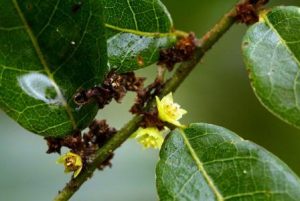
Bridelia cathartica. Photo: Bart Wursten. Source: Flora of Zimbabwe
New Blooms. Of the few trees which flower in April the following have been seen: Salix mucronata in the spillway, on higher ground there is Bridelia cathartica, Ficus thonningii, Rhus tenuinervis, Senna singueana is in bus. Everything is growing with April’s showers, this is wonderful after last year’s terrible drought.
Household woods, we shall not forget what Phoebe parosa is, she sounds like ‘ambuya’ thank you Maureen for this information”, does the miscellaneous file explain touch wood? There are three or more kinds of trees which yield lustrous timber which are described as satinwood, one such is Zanthoxylum flavum of the west Indies. Its local name is yellow heart prickly ash. Now this is related to our Zanthoxylum chilybeum. Many years ago we received, by parcel post, two huge pieces of this from Trevor Gordon. This sample has pride of place because of the stout woody bosses on the bark. Satinwoods are used in cabinet making. -This information provides incentive to cut and polish a tangential portion of Trevor‘s gift. Incidentally the cut end of a. branch of Dichrostachys, when seasoned, sand papered and suitably bored makes an interesting candlestick; as it happens there is a power failure now and Chinese lantern holds a tall candle.
Spelling Corrections : A Shona name for Ziziphus mucronata is muchecheni, an Acacia. with pale-coloured straight spines is mubayamhondoro, no offence meant, it was a handwriting error.
A Tree Snake : On the evening of St. Patrick’s day a handsome small snake, banished from Ireland, came into the house, it was swept into the guest bathroom for the night, escape routes were sealed. It coiled its tail on chair leg and later on mug and brush holder and explored from there. By mid-morning it had vanished and defied all efforts to be found. At about 1900 hours it re-appeared above the shaver light, presumably it spent the day behind this fitting. The snake was adept at avoiding the open pillow case when it was taken away. The visitor was easily recognised (it is illustrated on the dust-cover of a snake
field guide by V.F.M. Fitzsimmons) a common Tiger Snake; mainly terrestrial in habit but sometimes found in shrubs and small trees seeking birds‘ eggs and nestlings. It had found a good feeding place where lizards, geckos of all sizes including Bibrons, and occasionally dormice occur.
A Ring Porous Wood : This technical term is not likely to occur in popular books on trees. Pemission from Chepstow Farm next door was obtained in order to cut a piece of Vitex payos without being arrested by Tredar’s security guards. The timber of this tree has the distinction of being one of the few indigenous species which is ring porus, this feature is more often present in temperate climate vegetation. This arrangement of tissues can be seen using a ‘times ten‘ lens on the cut and of a branch. It occurs in the growth rings which are fairly well defined in Vitex_payos. Here is the definition of this term from the book “Indigenous timbers of Zimbabwe”, it is the arrangement of the large earlywood and small thicker walledd latewood vessels, or pores of hardwoods, in well-defined alternating rings, usually visible to the naked eye on the end grain. Wood-workers are aware of this structure because it determines the texture of timber. It takes a while to get used to focussing on these tissues and to learn what is what. Semi-ring porous well known indigenous trees are Dombeya rotundifolia and Combretum zeyheri. The opposite of ring porous is diffuse porous, this means that the vessels and fibres are distributed relatively evenly, not in zones. English beech wood is the classic example of a wood which is easy to ‘finish’ its texture is even because it is not ring porous. As this is rather heavy going, this is only half the story.
It may interest some people that my husband and I go to the memorial service for the late Colonel Sir Henry Abel Smith to be held in the Guards Chapel, Pall Mall, London on April 28th 1993.
-Benedicta Graves
BOTANIC GARDEN WALK: 6 April 1993
About 13 people gathered at the Herbarium for as second look at Eastern Districts trees, in preparation for the Tree Society’s outing to Nyanga at Easter. The following is a selection selection of the trees and plants seen.
At the base of the little kcpje was a small tree of Calpurnia aurea. Tom explaimed that this is usually a shrub or small tree but at Nyanga, it can be a proper tree attaining 20 metres in height. It is a legume (subfamily PAPILIONOIDEAE) and is widely cultivated. As well as occurring in the Eastern Districts it is also to be found in forest outliers, for example at Shurugwi.
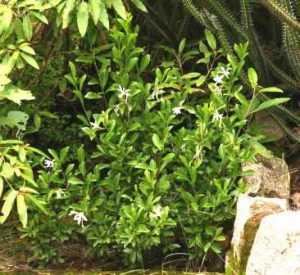
Turraea obtusifolia. Photo: Bart Wursten. Source: Flora of Zimbabwe
Nearby was a small shrub with beautiful white flowers. Tom named this Turraea obtusifolia.
We also examined Apodytes dimidiate. Tom pointed out that this is one of those species which gives an Eastern Districts flavour to the high veld. Other species which do this include Pittosporum viridiflorum, Erythroxylum emarginatum, Diospyros whytena and Maesa lanceolata.
At the top of the hill, we entered the forest edge flora and we revised some of the trees seen last month, such as Rapanea. Many of us found this revision embarrassingly necessary.
In the more herbaceous beds, Tom showed us the spectacular purple flowers of a labiate Plectranthus chimanimaniensis (which despite its name is not a Chimanimani endemic. The small shrub with greyish-white leaves which is so characteristic of Nyanga is Helichrysum spendidum however the specimens in the Gardens were not in flower. Tall specimens of Hypericum revolutum, the St. John’s Wort which is very common at Nyanga were also examined.
Less spectacular but still of interest, was a shrubby herb, Anthospenmum ammanicides (family RUBIACEAE) which has a rather scruffy appearance, perhaps because the leaves, flowers and bracts tend to wither on the plant. This is a very common species in the Eastern Districts. Tom mentioned the very rare Anthospermmum vallicola, found near the top of Mt. Nyangani.
Finally, we picked our way in semi darkness carefully through the forest and back to the Herbarium. Once again, our grateful thanks to Tom for a stimulating session in the Botanic Gardens.
-Mark Hyde
PALMS – BOTANICAL GARDENS – KEW
Of all plants palms most readily evoke the tropics. It is in tropical regions. Particularly the rain forests of Malaysia and S.America that palms are most abundant and various, but some of the 2500 or so species grow spontaneously as far north as California and the Mediterranean and others as far south as S. Africa and New Zealand. Cultivation extends the range yet further and in the milder parts of Britain some, such as the windmill palm (Trachyctsrpus fortunei) which my be seen near the Main Gates at Kew, can be grown successfully out of doors. Fossils show that Palms ancestors, very similar to today’s palms flourished in pre-glacial times where southern England now is.
Palms are Monocotyledons, that is they belong in the same large plant group as grasses; lilies, irises etc, and in this they are unlike our British trees which are either broad-leaved, hard wood trees belonging to the other large group of Angiesperm plants, the Dioctyledons, or needle-leaved, cone-bearing softwood trees belonging to the Gymnosperms. The cycads which resemble palms in having unbranched trunks and a crown, of large leaves are cone-producing and so are placed with the Gyzmosperms.
Many palms like the Coconut and Date palms and the Canary Island palm familiar as a street trees on the Mediterranean coast have a crown of feather-like (Pinnate) leaves whilst another large group of which the windmill palm mentioned above-is one, have fan-shaped (palmate) leaves. These types are often referred to as Feather or Fan palms respectively, while there are also some species with undivided leaves or fish- tail shaped leaflets. Whilst a cylindrical unbranched trunk covered with the ring- like scars of shed leaves is characteristic of many palms, some are without a trunk and others produce a number of slender stems forming a bamboo-like cluster and one group called rattans or climbing palm, develop very long slender stems unable to support the leaves produced along them. These leaves have, however, their own grappling irons – rows of spines set the long whip-like tip of the frond which catch unto surrounding trees at successively higher levels of the forest canopy as the palm grows until the young leaves emerge beyond it into the sunshine. Rattan stems may be several hundred feet long.
The long stems or canes of the rattan used in building, for binding and forming the once well known Malacca Cane are one example of many useful products man has obtained for centuries from palms. The following names of palms are sufficient to indicate their usefulness to man :— Coconut, Date, Oil, Sage, Wax, Ivory Nut, Wine Raffia and Cane. (All of these except the Saga and Raffia palms can be seen in the Temperate or Palm Houses). In ancient Tamil poem lists 801 uses of the Palmyra palm (Borassus flabellifer) of India, every part of which is put to some use. The sugary sap is the source of toddy, arrack and jaggery. “The most ancient way of writing was upon the leaf of the palm tree” and terms we use in book production today – folio and leaf – remind us that paper began as ‘leaf’.
Palm flowers are generally small but produced in large numbers. On the Date palm flowers are male or female and borne on separate trees but many palms have both sexes on one tree, some bath in the same flower. Some palms flower once only, exhausting their stored food and using up the growing point at the tip in producing a mass of blossom, then fruiting and dying. Others, once flowering size has been reached will continue intermittent flowering; over a long period, up to 100 years in the case of the Date. Fruits range in size from very small to that of the Double coconut (Lodicea) of the Seychelles group of islands which can weigh as much as 50 lbs. This giant fruits takes 6 years to mature and is produced by a tree which may be 100 feet high and more than 100 years old.
Palms with their elegant evergreen leaves, conveniently shed and replaced by new growth at intervals, are popular plants for pot and tub cultivation and for patio, garden and roadside in warmer climes.
With acknowledgements and thanks to the author and publisher.
GEORGE HALL CHAIRMAN


